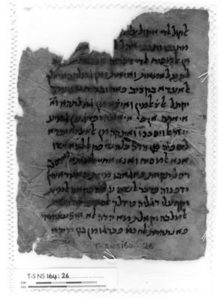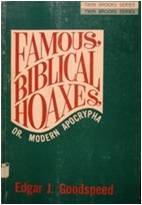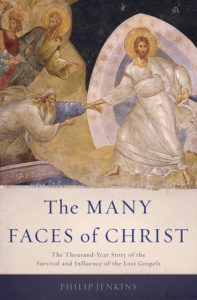2018 New Testament Apocrypha Course: Week 10
My New Testament Apocrypha course finished up last week with a class focusing on two aims: a look at anti-gospels (i.e., texts written by non-Christians for non-Christians to either lampoon or criticize Christianity, or to recast Jesus for a new religious system) and modern apocrypha. We also participated in an online chat session discussing Philip Jenkins’ book The Many Faces of Christ, which the students had to read for their book review assignment. As mentioned in previous posts about the course, York University is currently embroiled in a labour dispute, so the course has been continuing as a combination of online video lectures (the latest can be seen HERE) and chat sessions.
I began the lecture on anti-gospels with a short discussion of Christian-Jewish conflict in the first few centuries. I covered Mark’s apocalyptic discourse warning of being “handed over to councils and beaten in the synagogues” (13:9-13), John’s parents of the blind man who worried about being cast out of the synagogue for confessing Jesus as the Christ (9:22-23), arrests and executions of apostles in Acts, Paul’s issues with Judaizers, and several sections of Matthew (his genealogy which seems to anticipate criticism of Jesus’ conception, the slander of the disciples stealing the body of Jesus [28:11-15], and the declaration “Let his blood be on us and on our children!” [27:25]). These led into a discussion of Celsus’ The True Word and of possible references to Jesus in the Talmud.

Finally I arrived at the Toledoth Yeshu (the Life of Jesus) and we looked at some of its peculiar statements about Jesus: he was the son of “Joseph Pandera,” his miraculous abilities came from having stolen the Ineffable Name of God, his midair “defiling” battle with Judas, and Simon Kepha (identified also as Paul) as a double-agent of the Jews appointed to introduce Gentile practices into Christianity.
Then, after a brief look at Jesus in the Qur’an, I turned to the Gospel of Barnabas, a 16th-century retelling of the Gospels but with Jesus presented as a prophet and forerunner of Mohammad. I brought into the discussion a leather manuscript recovered from Turkish smugglers a few years ago. The initial reports claimed it was a 1500-year-old Syriac Bible (National Turk), but some have speculated that it is actually the Gospel of Barnabas (Vatican Insider). Instead it appears to be a Syriac copy of the Gospel of Matthew from around 1500. The first report continues to circulate on social media, so it was worthwhile discussing it in class, even though the text is not truly the Gospel of Barnabas. Also, it is a window into how the text is promoted by Muslims (it has been speculated that the reporting of the find was written by Muslims “infiltrating” the news media). For more on the link between the leather manuscript and the Gospel of Barnabas, read Annette Yoshiko Reed’s article “‘Muslim gospel’ excites ‘Da Vinci Code’ conspiracists.”
The second part of the video lecture took us from the late medieval period to the nineteenth and twentieth centuries with a look at the phenomenon of modern apocrypha. This was a new topic for this year’s version of the course, added because I have become interested in these texts since writing a paper on the topic for the 2015 York University Christian Apocrypha Symposium (“Apocrypha and Forgeries: Lessons from the ‘Lost Gospels’ of the Nineteenth Century”). For most scholars of the New Testament, as well as members of the wider public interested in their work, the study of Christian apocrypha focuses on texts of the first three centuries, the ones that were composed before the closing of the canon. Their interests are primarily in how orthodox Christianity defined itself against what it considered to be heresy, and how some early apocrypha may contain authentic traditions about the historical Jesus. Scholars working more deeply in the field of Christian apocrypha are increasingly looking at texts composed after the fourth century, such as the wave of “inventio” (invention) texts written to provide backstories for relics, festivals, or the locations of churches as Christianity established itself as an institution in the post-Constantinian world. But production of Christian apocrypha continued even after the Middle Ages. The next concentrated wave of texts came in the nineteenth century with the publication of newly-discovered gospels presenting Jesus as everything from an Essene to a Buddhist to a vegetarian. An anxious public, their faith eroded by attacks from higher biblical criticism on the canonical Gospels and their interest piqued by reports of lost gospels recovered from the Egyptian sands, provided an eager market for these new texts. We looked at some of these earlier in the course: two texts that claim to be continuations of the book of Acts, and the most recent modern apocryphon, the Gospel of Jesus’ Wife.
I divide modern apocrypha into two types: revealed texts, by which is meant a text dictated to its editor in the present day by a supernatural figure, whether Jesus or an angel (such as the Aquarian Gospel of Jesus Christ and the Book of Mormon); and what can be called “scholarly” apocrypha—texts said to have been found in one or more ancient manuscripts and, in most cases, are presented more as an object of study than for spiritual reflection, even if their authors were often motivated by religious and/or spiritual concerns. The most well-known text of the second type is Nicolas Notovitch’s Life of St. Issa, which documents Jesus’ early years spent in India and Persia learning from the Brahmans and the Kshatriyas and teaching against the caste system, idol worship, and human sacrifice. The students were assigned Notovitch’s text for this week’s readings.
 Until recently, modern apocrypha attracted little interest from scholars, likely due to the widespread sense that once proven not to be ancient, they deserve little attention. The works important for the study of the material are Edgar J. Goodspeed’s Strange New Gospels (later retitled as Famous Biblical Hoaxes) and Per Beskow’s Strange Tales about Jesus. Also important is Pierluigi Piovanelli’s 2005 article “What Is a Christian Apocryphal Text and How Does It Work? Some Observations on Apocryphal Hermeneutics” (NedTT 59 [2005]: 31–40), which calls for serious, sympathetic study of the texts, and Laurie Maffly-Kipp’s 2010 collection of texts, American Scriptures.
Until recently, modern apocrypha attracted little interest from scholars, likely due to the widespread sense that once proven not to be ancient, they deserve little attention. The works important for the study of the material are Edgar J. Goodspeed’s Strange New Gospels (later retitled as Famous Biblical Hoaxes) and Per Beskow’s Strange Tales about Jesus. Also important is Pierluigi Piovanelli’s 2005 article “What Is a Christian Apocryphal Text and How Does It Work? Some Observations on Apocryphal Hermeneutics” (NedTT 59 [2005]: 31–40), which calls for serious, sympathetic study of the texts, and Laurie Maffly-Kipp’s 2010 collection of texts, American Scriptures.
Like Piovanelli, I approach the modern apocrypha sympathetically, not dismissing them as fakes and forgeries but as texts that reflect the interests of their time, just like all apocrypha do. If the modern texts are treated with contempt, then scholars fall into the pattern of the ancient heresiologists, who declared texts outside of their own interests to be inauthentic, derivative, spurious, forged, false. Goodspeed, for example, said of them: they have “baseless character,” having been “dredged up from obscure depths mostly beyond the ken of educated people,” and he only examined them to show that they were not “genuine documents of Christian antiquity.” Beskow is more irenic and occasionally excuses the texts as pious frauds. But when considering whether it is permissible to create new gospels for a modern age he says, “the Gospel forgeries are related to the real Gospels”—distinguished here as “documents of faith”—“just as false coins are to genuine coins: they are unoriginal imitations, more or less well done, and they pretend to be what they are not. Falseness cannot be a road towards creativity.”
Whatever the motives behind the creation of modern apocrypha—whimsy, lucre, to create support for theological or historical positions, to confound scholars—they are just as worthy of study as ancient apocrypha, as reflections of the interests, beliefs, practices, and knowledge of their time. They even inform the study of earlier apocrypha, because in them we can observe more clearly how apocrypha are created and how they are transformed over time, as well as how they continue to bring meaning to their readers even despite their dubious origins. Even the Gospel of Jesus’ Wife, though proven to be a forgery, is still worthy of study as a text reflecting the needs of a community that considers the notion of a married Jesus meaningful.
 The course came to a complete close with our discussion of Jenkins’ The Many Faces of Christ. In previous years I have assigned books that tend to be negative about the value of Christian apocrypha, such as Darrell L. Bock’s The Missing Gospels: Unearthing the Truth Behind Alternative Christianities, or Michael J. Kruger and Andreas J. Köstenberger’s The Heresy of Orthodoxy: How Contemporary Culture’s Fascination with Diversity Has Reshaped Our Understanding of Early Christianity. I brought in Jenkins’ book because it was new, but my views are far more in line with his than they are with these other writers and I think I will return to one of the previous books in future years so that the students get a chance to see some other perspectives in the course. The other books also work well with the final chapter of my book, Secret Scriptures Revealed, which responds to what I call “anti-Christian Apocrypha apologetics.” Jenkins has a bit of an apologetic goal in his book also, though it only really shows itself at the very end of the book. After spending 200 or so pages arguing for the study of apocrypha for how they have influenced Christian thought and culture over the centuries, Jenkins turns to a defense of canonical texts. He cautions against opening up the canon to apocryphal texts, and writes,
The course came to a complete close with our discussion of Jenkins’ The Many Faces of Christ. In previous years I have assigned books that tend to be negative about the value of Christian apocrypha, such as Darrell L. Bock’s The Missing Gospels: Unearthing the Truth Behind Alternative Christianities, or Michael J. Kruger and Andreas J. Köstenberger’s The Heresy of Orthodoxy: How Contemporary Culture’s Fascination with Diversity Has Reshaped Our Understanding of Early Christianity. I brought in Jenkins’ book because it was new, but my views are far more in line with his than they are with these other writers and I think I will return to one of the previous books in future years so that the students get a chance to see some other perspectives in the course. The other books also work well with the final chapter of my book, Secret Scriptures Revealed, which responds to what I call “anti-Christian Apocrypha apologetics.” Jenkins has a bit of an apologetic goal in his book also, though it only really shows itself at the very end of the book. After spending 200 or so pages arguing for the study of apocrypha for how they have influenced Christian thought and culture over the centuries, Jenkins turns to a defense of canonical texts. He cautions against opening up the canon to apocryphal texts, and writes,
Whatever their possible spiritual or cultural value, those alternative works cannot begin to compete as historical documents with the canonical gospels and epistles…Of course, the canonical texts do not attempt to be sober academic history in any modern sense, and they have their theological agendas; but they really do take us directly to the world of Christ and his immediate followers in ways that no other candidate can or ever would. They represent the essential historical core. Other works might be popular in particular times and places, but they cannot be placed in the same category of canon. They spoke beautifully at the time, but to a world that is now past, and it would be foolish to try to give them some perpetual status. (p. 252)
I was pleased to see that several of my students noted this “apologetic turn” in the book.I wrote a review of The Many Faces of Christ for the Catholic Historical Review back in 2016. I’ll finish up this post with that review so that readers get a better sense of the value of the book (and there is much that I like about it) and so my students can compare their reviews to mine (I have to read theirs, so it seems only fair for them to read mine).
Even readers with a casual interest in Christian apocrypha know the familiar myth of the “lost gospels”—that a developing orthodox Church created a canon that served their theological and political interests, declared all other texts about the early church “apocryphal,” and effectively suppressed the literature until its rediscovery in the past few centuries. Jenkins aims to correct this “questionable historical narrative” (p. 6) by demonstrating instead that apocryphal texts continued to be valued and employed—even created—by the Church long after efforts to close the canon in the fourth century.
Jenkins focuses on what he calls the “long middle” of Christian history, between 400 and 1500 CE (p. 25). He traces the use of supposedly “lost gospels” throughout the period, either through references in other works (including a mention of the Gospel of Thomas in 1285), manuscripts (the Gospel of Peter, for example, is found in an eighth-century codex), compilations of earlier texts (such as Jacob de Voragine’s The Golden Legend), festivals (created based on traditions found in such texts as the Protevangelium of James or the Dormition of Mary), doctrines (Christ’s Descent to Hell from the Gospel of Nicodemus), and their use in literature and drama (the Descent is used prominently, for example, in Dante Alghieri’s Inferno and in the York Mystery Plays).
Certainly the church did on occasion encourage churchgoers to avoid some texts, but outside the stretch of the Roman Empire, they were less able to do so. Jenkins discusses the use and survival of apocrypha in areas such as Britain, Ireland, Armenia, and Ethiopia. He notes also that in some areas the shape of the Bible was much different, including the expansive Ethiopic canon. Not only were apocryphal texts available in these areas, some were even considered canonical.
Jenkins illustrates well that early apocrypha that continued to fill a need in the Church were never lost, whereas those that did not merely fell out of use. Only in a few cases, he argues, were texts actually actively suppressed; for the most part, they simply “lost their audiences, perhaps because they were felt to be irrelevant or old-fashioned,” or their contents were “absorbed into more substantial or better-written works” (p. 32). New apocrypha were also created to satisfy new needs, and some attention is paid by Jenkins to apocrypha created by the Bogomils such as the Secret Supper (p. 179-82) and modern texts such as the Archko Volume (p. 246-47).
Some texts are missing, of course. Jenkins could say more about apocrypha circulating in Syriac Christianity (of which he is quite knowledgeable), and apocrypha created in late antiquity—particularly in Coptic Christianity, where we see the creation of the genre of “pseudo-apostolic memoirs,” but also in the West and Greek East—to establish festivals and shrines for the post-Constantinian world.
For the most part Jenkins is positive about the value of reading apocryphal texts for understanding Christian history and art, but at the end of the book he strays into apologetic territory, decrying efforts to change the canon, and championing the canonical texts as better “historical documents” (p. 252). Also, Jenkins’ argument that apocrypha were rarely suppressed lacks some certainty. This is observable in his constant back-and-forth statements about their suppression (e.g., “ordinary people were losing access to the old traditions,” p. 235) and their endurance (e.g., only two pages later we read, “Noncanonical scriptures were never wholly absent from church life,” p. 237).
Jenkins’ arguments are not entirely new to scholars of Christian apocrypha and cognate disciplines such as Medieval Studies, many of whom have been trying to bring attention to late-antique and medieval apocrypha for some time. But he masterfully assembles a broad range of historical data about these more recent works and their use in the “long middle.” There is something new here even for the seasoned scholar and Jenkins presents the material in a way that is captivating for non-scholars.
And that’s a wrap for New Testament Apocrypha for this year. I hope you’ve enjoyed reading these posts. It was a great group of students this year; I thoroughly enjoyed teaching the course.
